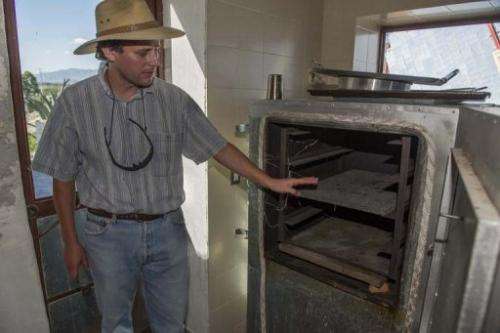German's solar ovens make sunbaked tortillas in Mexico

Under a blazing sun in Mexico's central mountain range, a clutch of large dish-shaped solar panels suck up the light and beam the heat into a kitchen, cooking tortillas.
Forget coal, gas or electric ovens. German entrepreneur Gregor Schapers designed and installed giant circular solar panels in the small town of El Sauz to show that the sun's rays can cook up a storm too.
Schapers, who has lived in this town 180 kilometers (110 miles) north of Mexico City since 2003, hopes that this environmentally-friendly solar cooker can ultimately slash energy bills in Mexico's poor rural communities.
"You can cook for a group of up to 60 people per reflector," Schapers told AFP, wearing a checkered shirt, sunglasses and a wide straw hat under a clear sky in the Sierra Madre Oriental mountain range.
He adapted solar energy-harnessing technology created by the Austrian Wolfgang Scheffler.
But the parts for his oversize solar cooker were all built in Mexico, by the company he founded, Trinysol.
"It's good for social and economic development in rural communities," he said of his cooker and the business of building it.
The glass and aluminum panels are either 10-square-meters or (107-square-foot) or 16-square-meters (170-square-foot) in size. Some are placed at a 45-degree angle while others rest almost horizontal, facing the sky.
The reflectors can generate temperatures hotter than 1,020 degrees Celsius (1,868 degrees Fahrenheit).
Once the powerful heat reaches the cooker, it is shared between a cauldron, a griddle to make tortillas, and an oven. The solar panels can be used in restaurants or bakeries.
The solar cooker system is costly to build, between $4,000 and $5,000 depending on size. But once it's set up, it produces free energy, Schapers said. Each reflector saves the equivalent of 60 liters (16 gallons) of gas each month.
And the oven is environmentally-friendly, using renewable energy and creating zero greenhouse gas emissions.
Schapers said his design makes some significant improvements over other existing models.
"The beauty of our system is that one can cook directly in the house," he explained. Other solar ovens require a cook to brave the outside elements.
Like sunflowers, his solar panels automatically turn toward the sun with the help of a light sensor.
In addition to heat, the solar reflectors can produce steam and Schapers is testing three other uses for his giant panels: a greenhouse project; honey production; and a system for steam baths.
"At first people here in the region were very skeptical about the usefulness of my project," Schapers said.
But he said the finished product has won them over.
"Once they saw the facilities and what we can do with these reflectors, they realized that they work."
(c) 2012 AFP


















